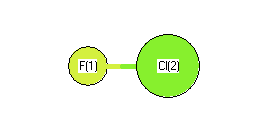Vibrational levels (cm-1) 
| Mode Number |
Symmetry |
Frequency |
Intensity |
Comment |
Description |
| Fundamental(cm-1) |
Harmonic(cm-1) |
Reference |
(km mol-1) |
unc. |
Reference |
| 1 |
Σ |
773 |
783 |
2007Iri:389 |
|
|
|
|
|
Detailed diatomic data
| ωe |
ωexe |
ωeye |
Be |
αe |
ZPE
| reference |
| 783.4534 |
4.9487 |
-0.0176 |
0.5164805 |
0.0043385 |
390.51 |
2007Iri:389 |
vibrational zero-point energy: 386.7 cm
-1 (from fundamental vibrations)
Calculated vibrational frequencies for
ClF
+ (clorine monofluoride cation).
More spectroscopic constants are available at the NIST Physics Laboratory website:
Geometric Data

Point Group C∞v
Internal coordinates
distances (r) in Å, angles (a) in degrees, dihedrals (d) in degrees
| Description |
Value |
unc. |
Connectivity |
Reference |
Comment |
| Atom 1 |
Atom 2 |
Atom 3 |
Atom 4 |
| rFCl |
1.628 |
0.000 |
1 |
2 |
|
|
NISTdiatomic |
re Cl(35) |
Cartesians
| Atom |
x (Å) |
y (Å) |
z (Å) |
| F1 |
0.0000 |
0.0000 |
0.0000 |
| Cl2 |
0.0000 |
0.0000 |
1.6283 |
Atom - Atom Distances 
Distances in Å
| |
F1 |
Cl2 |
| F1 |
|
1.6283 |
| Cl2 |
1.6283 |
|
Calculated geometries
for ClF
+ (clorine monofluoride cation).
Bond descriptions
Examples: C-C single bond, C=C, double bond, C#C triple bond, C:C aromatic bond
Connectivity
Dipole, Quadrupole and Polarizability
Electric dipole moment 
| State |
Config |
State description |
Conf description |
Exp. min. |
Dipole (Debye) |
Reference |
comment |
Point Group |
Components |
| x |
y |
z |
total |
dipole |
quadrupole |
| 1 |
1 |
1Σ+ |
C∞v |
True |
|
|
|
0.880 |
NSRDS-NBS10 |
MW |
C∞v |
1 |
1 |
Experimental dipole measurement abbreviations: MW microwave; DT Dielectric with Temperature variation; DR Indirect (usually an upper limit); MB Molecular beam
Calculated electric dipole moments for
ClF
+ (clorine monofluoride cation).
Electric quadrupole moment 
| State |
Config |
State description |
Conf description |
Exp. min. |
Quadrupole (D Å) |
Reference |
comment |
Point Group |
Components |
| xx |
yy |
zz |
dipole |
quadrupole |
| 1 |
1 |
1Σ+ |
C∞v |
True |
-0.670 |
-0.670 |
1.340 |
|
1.34+-1.0 |
C∞v |
1 |
1 |
Calculated electric quadrupole moments for
ClF
+ (clorine monofluoride cation).










